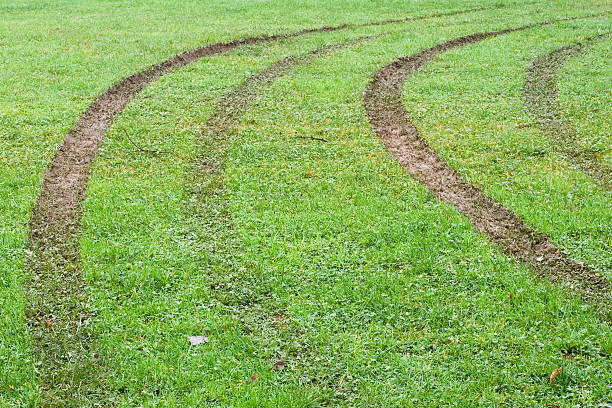Do you have tire ruts in your lawn? They can be a real eyesore, and they can also make it difficult to mow your lawn properly. In this blog post, we will discuss how to fix tire ruts in your lawn. We will provide step-by-step instructions on how to do it, as well as some tips and tricks that will help make the process easier. So, if you’re tired of looking at those pesky tire ruts, keep reading!

The Consequences of Not Fixing a Rut
Any time you see a rut in your lawn, it’s time to take action. Ruts not only mar the appearance of your lawn, but they can also cause long-term damage. Ruts are caused by repeated traffic over the same area of turf, which compacts the soil and prevents air and water from reaching the roots. This can lead to brown patches, bare spots, and even deceased grass. In addition, ruts can act as channels for rainwater, directing water away from your lawn and towards your foundation.
As a result, fixing ruts as soon as they appear is essential for maintaining a healthy lawn. Fortunately, repairing ruts is relatively simple. First, remove any debris or dead grass from the affected area. Next, loosen the compacted soil with a garden fork or aerator. Finally, spread new seed over the area and water regularly until the grass has taken root. By following these steps, you can quickly repair any ruts in your lawn and restore its beauty.
Also Read: How to Fix an Over Fertilized Lawn: Tips for Bringing Your Grass Back to Life
How Can You Avoid Getting Ruts in the First Place?
Ruts are usually caused by two things: compaction and poor drainage. Compaction occurs when the ground is heavily trafficked, or equipment is driven over it repeatedly. This can be a problem in high traffic areas, like driveways, parking lots, and sidewalks. Poor drainage occurs when water collects on the surface of the ground instead of seeping down into the soil. This can happen when the ground is too flat, there’s not enough drainage, or the soil is impermeable (like clay). There are a few things you can do to prevent ruts:
- Use mulch or gravel in high traffic areas. This will help to keep the ground from getting compacted.
- Make sure your gutters and downspouts are clean and clear. This will help water to drain away from your home and Foundation.
- Improve drainage by adding French drains, swales, or other drainage features to your yard.
- Avoid driving on wet ground. If you must drive on wet ground, try to drive in the same direction each time to avoid creating ruts.
How to Repair Ruts in Your Lawn
Over time, lawns can develop ruts from heavy foot traffic or from vehicles driving over them. Ruts not only make your lawn look bad, but they can also damage the grass and make it more difficult to mow. If you have ruts in your lawn, there are a few things you can do to repair them. First, if the ruts are shallow, you can simply fill them in with topsoil or sand. Be sure to compact the material before planting new grass seed. For deeper ruts, you may need to remove the sod and start over. Be sure to till the soil before planting new seed. You should also add a layer of compost to help the new grass take root. With a little effort, you can repair ruts and have a healthy, green lawn again.
How to Prevent Digging Yard Paths
Over time, your lawn will start to show signs of wear and tear. Foot traffic, heavy equipment, and extreme weather can all cause ruts to form in your yard. While these depressions may not seem like a big deal at first, they can quickly become a safety hazard. And if left untreated, they can also lead to long-term damage to your lawn.
So how do you fix tire ruts in your lawn? The first step is to figure out what’s causing them. If you’re regularly driving over the same spot or operating heavy machinery in your yard, those activities will need to stop. You might also need to adjust your irrigation system if it’s causing waterlogged areas that are susceptible to rutting. Once you’ve identified the cause of the problem, you can start repairing the damage. For small ruts, simply remove any loose debris and fill the depression with fresh soil. For larger ruts, you may need to use a power tiller to loosen the compacted soil before adding new soil and reseeding the area. By taking these steps, you can keep your lawn looking its best for years to come.
Tire Depressions in a Lawn
Tire depressions in a lawn can be unsightly and cause problems for your grass. Tire depressions occur when a tire is driven over wet grass and the weight of the vehicle compresses the blades of grass, causing them to bend and break. In some cases, the tire may even penetrate the soil, leaving a crater-like depression.
Tire depressions can be difficult to repair, as they often compact the soil, making it difficult for new grass to take root. In addition, tire depressions can act as barriers to water and air flow, which can lead to further damage to your lawn. If you have tire depressions in your lawn, it is important to take steps to repair them as soon as possible to prevent further damage.
